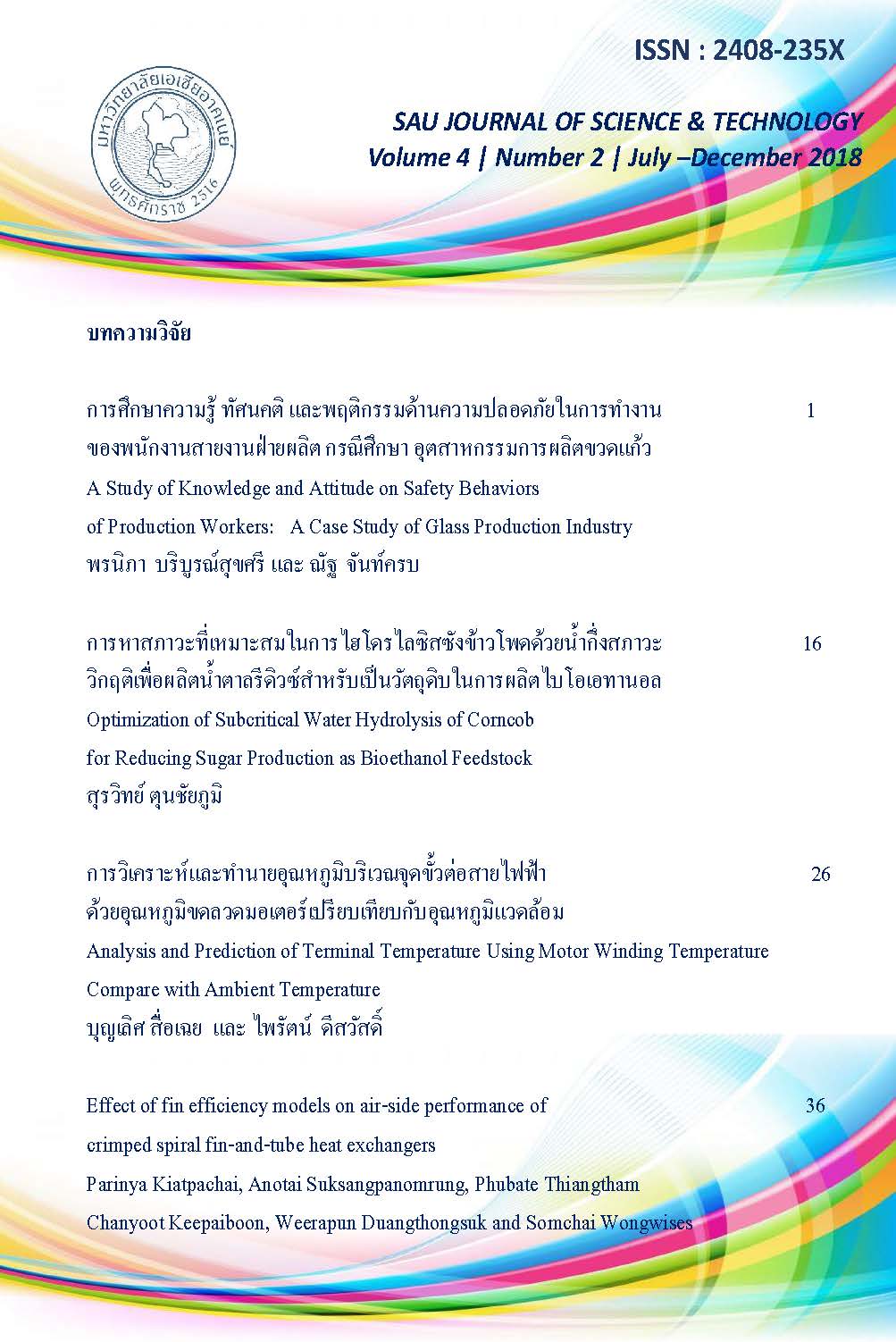Effect of fin efficiency models on air-side performance of crimped spiral fin-and-tube heat exchangers
Main Article Content
Abstract
In this study, we investigate the effect of fin efficiency (hf) models on the airside performance (ASPs) of crimped, spiral fin and tube heat exchangers (SHXs). The analysis of ASP is calculated using different fin efficiency models based on the assumptions of constant heat flux for each Reynolds number, constant heat transfer area with negligible fin thickness, and constant fin geometry for four exanimate heat exchangers (HX). The L-Rectangular, L-Convex, L-Triangular, and L-Concave models of longitudinal fin efficiency are used in the calculation and compared with the R-Rectangular model for radial fin efficiency that looks more realistic than the tested crimped spiral fin. The four samples are the crimped SHX. The well-insulated, open wind tunnel is used for heat transfer between two working fluids, i.e., ambient air and hot water. The experiment is carried out over a range of Vfr (1-6 m/s) or Redo of 3,000 to 12,000. The results show that the L-Triangular, L-Convex, and L-Rectangular models for fin efficiency provide trends of heat transfer coefficients that are more similar to the realistic R-Rectangular model. However, we found another model over-predicting the heat transfer coefficient by as much as 5-10%. This model uses the L-Concave model of fin efficiency with various Cu and Al fins, each with 3 or 4 tube rows. Moreover, we demonstrate a similar trend and value for fin efficiency between L-Triangular and R-Rectangular models. The effect of fin efficiency models and fin materials has a strong variation in terms of fin efficiency. In contrast, the number of tube rows, whether 3 or 4, has no significant effect on fin efficiency. This proposed research can be generally applied to selection of a model by fin efficiency and prediction of safety factors in designing crimped SHX.
Article Details
References
[2] S. Wongwises and P. Naphon, “Heat transfer characteristics of a spiral-coil finned tube heat exchanger under dry-surface conditions,” Heat Transfer Eng., Vol.27, pp.25-34, 2006.
[3] S. Wongwises and P. Naphon, “Thermal performance of a spiral-coil finned tube heat exchanger under wet-surface conditions,” J. Mech. Sci. Technol., Vol.20, pp.212-226, 2006.
[4] A. Nuntaphan, T. Kiatsiriroat and C.C. Wang, “Air side performance at low Reynolds number of cross-flow heat exchanger using crimped spiral fins,” Int Communications in Heat and Mass Transfer, Vol.32, pp.151-165, 2005.
[5] A. Nuntaphan, T. Kiatsiriroat and C.C. Wang, “Heat transfer and friction characteristics of crimped spiral finned heat exchanger with dehumidification,” Applied Thermal Engineering, Vol.25, pp.327-340, 2005.
[6] P. Pongsoi, S. Pikulkajorn and S. “Wongwises, Heat Transfer and Flow Characteristics of Spiral Fin-and-Tube Heat Exchangers: A Review,” Int. Journal of Heat and Mass Transfer, Vol.79, pp.417-431, 2014.
[7] P. Pongsoi, S. Pikulkajorn, C.C. Wang and S. Wongwises, “Effect of fin pitches on the air-side performance of crimped spiral fin-and-tube heat exchangers with a multipass parallel and counter cross-flow configuration,” Int. Journal of Heat and Mass Transfer,Vol.54, no.9-10, pp.2234-2240, 2011.
[8] P. Pongsoi, S. Pikulkajorn, C.C. Wang and S. Wongwises, “Effect of number of tube rows on the airside performance of crimped spiral fin-and-tube heat exchangers with a multipass parallel andcounter cross-flow configuration,” Int. Journal of Heat and Mass Transfer, Vol.55, no.4, pp. 1403-1411, 2012.
[9]P. Pongsoi, S. Pikulkajorn and S. Wongwises, “Effect of fin pitches on the optimum heat transfer performance of crimped spiral fin-and-tube heat exchangers,” Int. Journal of Heat and Mass Transfer, Vol.55, no.23-24, pp.6555-6566, 2012.
[10]P. Pongsoi, S. Pikulkajorn and S. Wongwises, “Experimental study on the air-side performance of a Multipass parallel and counter cross-flow L-footed spiral fin-and-tube heat exchanger,” Heat Transfer Engineering, Vol.33, no.15, pp.1251-1263, 2012.
[11]P. Pongsoi, P. Promoppatum, S. Pikulkajorn and S. Wongwises, “Effect of fin pitches on the air-side performance of L-footed spiral fin-and-tube heat exchangers,” Int. Journal of Heat and Mass Transfer, Vol.59, pp.75-82, 2013.
[12]P. Pongsoi and S. Wongwises, “Determination of fin pitches for maximum performance index of L-footed spiral fin-and-tube heat exchangers,” Journal of Thermal Engineering, Vol.1, no.1, pp.251-261, 2015.
[13]P. Kiatpachai, S. Pikulkajorn and S. Wongwises, “Air-Side Performance of Serrated Welded Spiral Fin-and-Tube Heat Exchangers,” International journal of heat and mass transfer, Vol.89, pp. 724-732, 2015.
[14]E.M.A. Mokheimer, “Performance of annular fins with different profiles subject to variable heat transfer coefficient,” Int. J. Heat and Mass Transfer, Vol.45, pp.3631-3642, 2002.
[15]E.M.A. Mokheimer, “Heat transfer from extended surface subject to variable heat transfer coefficient,” Heat and Mass Transfer, Vol.39, pp.131-138, 2003.
[16]D.E. Briggs and E.H. Young, “Convective heat transfer and pressure drop of air flowingacross triangular pitch banks of finned tubes,” Chem. Eng. Prog. Symp Ser., Vol.59, no.41, pp.1–10, 1963.
[17]C.C. Wang and C.T. Chang, “Heat and mass transfer for plate fin-and-tube heat exchangers with and without hydrophilic coating,” Int. J. Heat Mass Transfer, Vol.41, pp.3109–3120, 1998.
[18]C.C. Wang, Y.J. Chang, Y.C. Hsieh and Y.T. Lin, “Sensible heat and friction characteristics of plate fin-and-tube heat exchangers having plane fins,” Int. J. Refrig., Vol.19, no.4, pp.223–230, 1996.
[19]V. Gnielinski, “New eguation for heat and mass transfer in turbulent pipe and channel flow,” Int. Chem. Eng., Vol.16, pp.359–368, 1976.
[20]K.A. Gardner, “Efficient of Extended Surface, ASME Trans.”, Vol.67, pp.621, 1945.
[21]W.M. Kays, A. London, Compact heat exchangers, 3rd Ed., Mcgraw-Hill, New York, 1984.
[22]Y.G. Park, “Correcting energy balance error in heat exchanger data by maximum likelihood method,” Applied Thermal Engineering, Vol. 131, pp.311–319, 2018.
[23] S. Kakac, H. Liu and A.Pramuanjaroenkij, Heat Exchangers: Selection, Rating and Thermal Design, 3rd ed. Boca Raton, FL: CRC Press. Kakaç, S., 2012.


